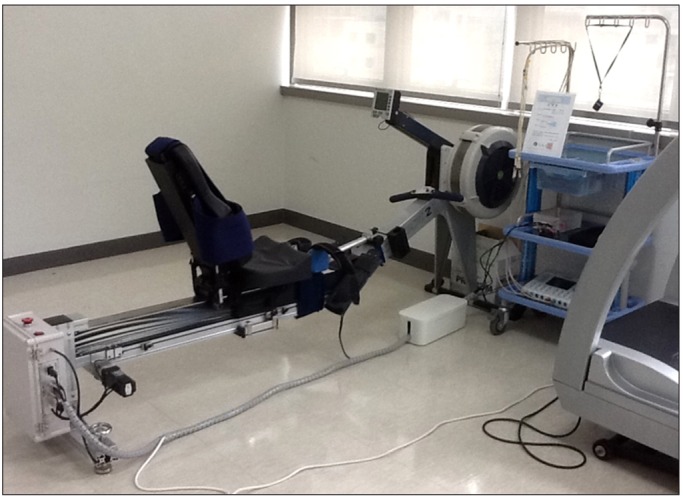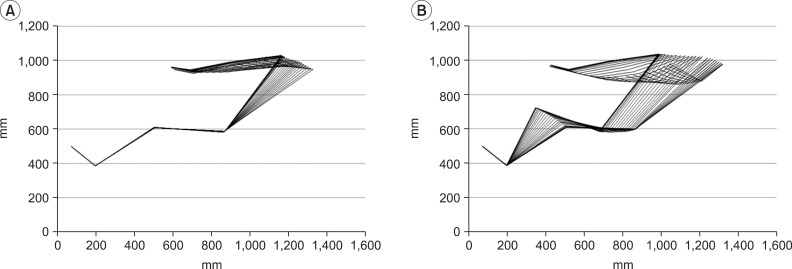Ann Rehabil Med.
2012 Jun;36(3):379-385. 10.5535/arm.2012.36.3.379.
Development of a Motor Driven Rowing Machine with Automatic Functional Electrical Stimulation Controller for Individuals with Paraplegia; a Preliminary Study
- Affiliations
-
- 1Department of Motor and Cognitive Function Rehabilitation, National Rehabilitation Research Institute, Seoul 142-884, Korea. daeric7@gmail.com
- 2Department of Rehabilitation Medicine, National Rehabilitation Hospital, Seoul 142-884, Korea.
- KMID: 2266744
- DOI: http://doi.org/10.5535/arm.2012.36.3.379
Abstract
OBJECTIVE
To examine the cardiorespiratory responses of patients with spinal cord injury (SCI) paraplegia using a motor driven rowing machine. METHOD: Ten SCI patients with paraplegia [A (n=6), B (n=1), and C (n=3) by the American Spinal Injury Association impairment scale] were selected. Two rowing techniques were used. The first used a fixed seat with rowing achieved using only upper extremity movement (fixed rowing). The second used an automatically moving seat, facilitating active upper extremity movement and passive lower extremity movement via the motorized seat (motor rowing). Each patient performed two randomly assigned rowing exercise stress tests 1-3 days apart. The work rate (WR), time, respiratory exchange ratio (R), oxygen consumption (VO2), heart rate (HR), metabolic equivalents (METs), and rating of perceived exertion (RPE) were recorded.
RESULTS
WR, time, VO2, and METs were significantly higher after the motor rowing test than after fixed motor rowing test (p<0.05). HR after motor rowing was significantly lower than fixed rowing (p<0.05).
CONCLUSION
Cardiorespiratory responses as VO2, HR and METs can be elicited by the motor rowing for people with paraplegic SCI.
MeSH Terms
Figure
Reference
-
1. Bostom AG, Toner MM, McArdle WD, Montelione T, Brown CD, Stein RA. Lipid and lipoprotein profiles relate to peak aerobic power in spinal cord injured men. Med Sci Sports Exerc. 1991; 23:409–414. PMID: 2056897.
Article2. Van Houtte S, Vanlandewijck Y, Gosselink R. Respiratory muscle training in persons with spinal cord injury: a systematic review. Respir Med. 2006; 100:1886–1895. PMID: 16626951.
Article3. Phillips WT, Kiratli BJ, Sarkarati M, Weraarchakul G, Myers J, Franklin BA, Parkash I, Froelicher V. Effect of spinal cord injury on the heart and cardiovascular fitness. Curr Probl Cardiol. 1998; 23:641–716. PMID: 9830574.
Article4. Verellen J, Vanlandewijck Y, Andrews B, Wheeler GD. Cardiorespiratory responses during arm ergometry, functional electrical stimulation cycling, and two hybrid exercise conditions in spinal cord injured. Disabil Rehabil Assist Technol. 2007; 2:127–132. PMID: 19263547.
Article5. Wheeler GD, Andrews B, Lederer R, Davoodi R, Natho K, Weiss C, Jeon J, Bhambhani Y, Steadward RD. Functional electric stimulation-assisted rowing: increasing cardiovascular fitness through functional electric stimulation rowing training in persons with spinal cord injury. Arch Phys Med Rehabil. 2002; 83:1093–1099. PMID: 12161830.
Article6. Olenik LM, Laskin JJ, Burnham R, Wheeler GD, Steadward RD. Efficacy of rowing, backward wheeling and isolated scapular retractor exercise as remedial strength activities for wheelchair users: application of electromyography. Paraplegia. 1995; 33:148–152. PMID: 7784117.
Article7. Johnston TE, Smith BT, Betz RR, Lauer RT. Exercise testing using upper extremity ergometry in pediatric spinal cord injury. Pediatr Phys Ther. 2008; 20:146–151. PMID: 18480713.
Article8. Valent L, Dallmeijer A, Houdijk H, Slootman HJ, Janssen TW, Van Der Woude LH. Effects of hand cycle training on wheelchair capacity during clinical rehabilitation in persons with a spinal cord injury. Disabil Rehabil. 2010; 32:2191–2200. PMID: 20726737.
Article9. Dallmeijer AJ, van der Woude LH. Health related functional status in men with spinal cord injury: relationship with lesion level and endurance capacity. Spinal Cord. 2001; 39:577–583. PMID: 11641807.
Article10. Gass EM, Gass GC. Thermoregulatory responses to repeated warm water immersion in subjects who are paraplegic. Spinal Cord. 2001; 39:149–155. PMID: 11326325.
Article11. Keyser RE, Rasch EK, Finley M, Rodgers MM. Improved upper-body endurance following a 12-week home exercise program for manual wheelchair users. J Rehabil Res Dev. 2003; 40:501–510. PMID: 15077662.
Article12. Halliday SE, Zavatsky AB, Hase K. Can functional electric stimulation-assisted rowing reproduce a racewinning rowing stroke? Arch Phys Med Rehabil. 2004; 85:1265–1272. PMID: 15295751.13. Hettinga DM, Andrews BJ. The feasibility of functional electrical stimulation indoor rowing for high-energy training and sport. Neuromodulation. 2007; 10:291–297. PMID: 22150841.
Article14. Davoodi R, Andrews BJ, Wheeler GD, Lederer R. Development of an indoor rowing machine with manual FES controller for total body exercise in paraplegia. IEEE Trans Neural Syst Rehabil Eng. 2002; 10:197–203. PMID: 12503785.
Article15. Ragnarsson KT. Functional electrical stimulation after spinal cord injury: current use, therapeutic effects and future directions. Spinal Cord. 2008; 46:255–274. PMID: 17846639.
Article16. Park DS, Lee BS, Kim DA, Kim M, Ryu BJ. Development of a new motor-driven rowing machine for the patients with spinal cord injury. 2009. In : Proceeding of the 48th International Spinal Cord Society Annual Scientific Meeting; 2009 Oct 21-24; Firenze, Italy. Florence: International Spinal Cord Society.17. Park DS, Lee BS, Kim M. A comparison of oxygen consumption test with a motor-driven rowing and arm ergometer in the patients with spinal cord injury. Journal of Special Education & Rehabilitation Science. 2011; 50:385–398.18. Borg G. Ratings of perceived exertion and heart rates during short-term cycle exercise and their use in a new cycling strength test. Int J Sports Med. 1982; 3:153–158. PMID: 7129724.
Article19. Bassett DR Jr, Howley ET. Limiting factors for maximum oxygen uptake and determinants of endurance performance. Med Sci Sports Exerc. 2000; 32:70–84. PMID: 10647532.
Article20. Yoshiga CC, Higuchi M. Heart rate is lower during ergometer rowing than during treadmill running. Eur J Appl Physiol. 2002; 87:97–100. PMID: 12070617.
Article21. Jeon JY, Weiss CB, Steadward RD, Ryan E, Burnham RS, Bell G, Chilibeck P, Wheeler GD. Improved glucose tolerance and insulin sensitivity after electrical stimulation-assisted cycling in people with spinal cord injury. Spinal Cord. 2002; 40:110–117. PMID: 11859437.
Article22. Knechtle B, Muller G, Willmann F, Eser P, Knecht H. Comparison of fat oxidation in arm cranking in spinal cord-injured people versus ergometry in cyclists. Eur J Appl Physiol. 2003; 90:614–619. PMID: 12923642.
Article23. Lewis JE, Nash MS, Hamm LF, Martins SC, Groah SL. The relationship between perceived exertion and physiologic indicators of stress during graded arm exercise in persons with spinal cord injuries. Arch Phys Med Rehabil. 2007; 88:1205–1211. PMID: 17826469.
Article24. El-Sayed MS, Younesian A, Rahman K, Ismail FM, El-Sayed Ali Z. The effects of arm cranking exercise and training on platelet aggregation in male spinal cord individuals. Thromb Res. 2004; 113:129–136. PMID: 15115668.
Article25. Ainsworth BE, Haskell WL, Whitt MC, Irwin ML, Swartz AM, Strath SJ, O'Brien WL, Bassett DR Jr, Schmitz KH, Emplaincourt PO, et al. Compendium of physical activities: an update of activity codes and MET intensities. Med Sci Sports Exerc. 2000; 32:S498–S504. PMID: 10993420.
Article26. Capodaglio P, Grilli C, Bazzini G. Tolerable exercise intensity in the early rehabilitation of paraplegic patients. A preliminary study. Spinal Cord. 1996; 34:684–669. PMID: 8918967.
Article27. Hopman MT, Monroe M, Dueck C, Phillips WT, Skinner JS. Blood redistribution and circulatory responses to submaximal arm exercise in persons with spinal cord injury. Scand J Rehabil Med. 1998; 30:167–174. PMID: 9782544.
- Full Text Links
- Actions
-
Cited
- CITED
-
- Close
- Share
- Similar articles
-
- Rewiring the Lesioned Brain: Electrical Stimulation for Post-Stroke Motor Restoration
- Fundamental Study for Rolling-Over Motion of the Body by Functional Electrical Stimulation (FES)
- Functional Electrical Stimulation
- The Optimal Electrical Stimulation Frequency to Improve the Muscle Endurance in Spinal Cord Injured Rabbit
- The Changes of Motor Evoked Potential and Silent Period after Electrical Stimulation in Stroke Patients



